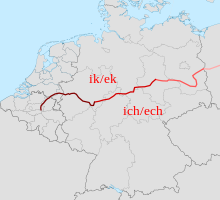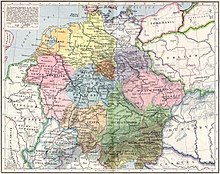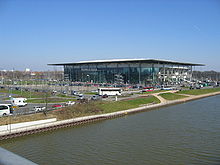Northern Germany

Northern Germany (German: Norddeutschland, pronounced [ˈnɔʁtdɔɪ̯tʃlant] ⓘ) is a linguistic, geographic, socio-cultural and historic region in the northern part of Germany which includes the coastal states of Schleswig-Holstein, Mecklenburg-Vorpommern and Lower Saxony and the two city-states Hamburg and Bremen. It contrasts with Southern Germany, Western Germany and Eastern Germany.
Language

Northern Germany generally refers to the
Although from the 19th century onwards, the use of
Geography
The key terrain feature of Northern Germany is the
.These features were formed during the Weichselian glaciation and contrast topographically with the adjacent Central Uplands of Germany to the south, such as the Harz and Teutoburg Forest, which are occasionally counted as part of Northern Germany.
Culture
Northern Germany has traditionally been dominated by
Culturally and socially, Northern Germany is characterized by higher levels of income equality and gender equality than southern and south-western Germany. While the national federal Gini coefficient for Germany stands at around 30, the southern states have a Gini coefficient of 30.6 whereas for the Northern states the Gini coefficient stands at 27.5 which is closer to the Scandinavian average of 25. Traditional society in the western part of Northern Germany (Schleswig-Holstein, Lower Saxony and some parts of North Rhine-Westphalia and Saxony-Anhalt) until the early 20th century was based on well-off, literate and landowning yeoman farmers owning relatively large pieces of land, making a living growing grain crops and raising dairy cattle and pigs, and a large and educated middle class in the towns and cities working in the civil service, or as businessmen, artisans, blue-collar workers and skilled workers. Thus, the proportion of serfs, landless labourers, semi-skilled industrial workers and large landlords was relatively smaller, making for a more stable society than elsewhere in Germany like the Rhineland region and the region east of the Elbe river. Additionally, Northern cities like Hamburg, Bremen and Rostock have always been economic powerhouses of trade and commerce and have had a long tradition of innovation and creativity in business and industry.
Cuisine
The traditional northern German daily diet is centered around boiled
Drinking coffee is firmly rooted in northern Germany and the northern provinces on average consume around 8 kilograms (18 lb) of coffee per capita annually. This is more than the 6 kilograms (13 lb) of coffee per capita consumed in the south. Coffee is frequently drunk four times a day: at breakfast, after lunch, in the evening at around 4 pm, and after dinner. Many people also drink a coffee at their place of work at the start of the day's work, and a coffee break with colleagues around an hour before or after lunch. There is also a strong tradition of taking coffee breaks and visiting cafés with friends and acquaintances. In places such as publicly funded universities where free coffee is not available to students, it is not uncommon for students to bring their own hot coffee in insulated flasks and drink from it intermittently. Cafés usually offer medium-fat milk and
The northwesternmost region of East Frisia is an exception insofar as tea is largely preferred over coffee there, to the extent that East Frisians drink about 300 litres (79 US gal) of tea per capita and year, more than in any particular country.[2]
Lunch at workplaces and educational institutions in northern Germany begins very early – usually between 11:45 and 12:15 pm, and dinner is usually eaten between 7 and 8 pm in the evening. This is because the work and school day starts pretty early, at 8 am sharp. Lunches eaten at home during holidays and weekends usually start later – around 1 pm.
The drinking culture in the north is more or less similar to that of the rest of the country, heavily based on
History

Saxony in yellow (c. 1000 AD)
In the
From 1500 onwards, the former Saxon territories (except for Westphalia) were incorporated into the Lower Saxon Circle of the Holy Roman Empire. The Hanseatic League is also part of the common history and culture of the cities in northern Germany.
Northern Germany corresponds to the territory of the
Cultural or political east–west divisions have existed in northern Germany since at least the early modern period, when
- the easternmost and southeastern part (mainly East Prussia, Brandenburgian Pomerania, and Brandenburg) was owned by or part of the State of the Teutonic Order and later Brandenburg-Prussia,
- the middle part (the island of Rügen, parts of Western Pomerania, eastern coastal regions of Schleswig-Holstein, and a fragmented Mecklenburg in the middle) during the Early Middle Ages was at least in parts inhabited by a large Slavic population (see Obotrites and Veleti) and for a long time from the High Middle Ages onwards was first under Danish (Principality of Rügen, 1168–1365), then Swedish influence as Swedish Pomerania (1628-1807/15),
- and the Western part (today most of Schleswig-Holstein and all of British Zone of Occupation in Allied-occupied Germanybetween 1945–49.
During the
A number of Scottish and English Lutheran Families settled in Northern Germany between the years 1683 and 1709, with the result that many Germans in Northwest Germany can claim Scottish and English ancestry.[3]
Northern German states
The term northern German states is always used to refer to the following coastal federal States of Germany:
In some cases, it also includes the non-coastal states of:
Northern Germany as a region or as a historical landscape includes additional federal states (see geography above). Northwestern Germany is usually considered to be part of Northern Europe both culturally and geographically where as the southern states are much closer to Central European cultures.
Major cities
Where a city has different names in English and German, the English name is given first.
| Federal capital | |
| State capital |
| Rank | City | Pop. 1950 |
Pop. 1960 |
Pop. 1970 |
Pop. 1980 |
Pop. 1990 |
Pop. 2000 |
Pop. 2010 |
Area [km2] |
Density per km2 |
Growth [%] (2000– 2010) |
surpassed 100,000 |
State (Bundesland) |
|---|---|---|---|---|---|---|---|---|---|---|---|---|---|
| 1. | 3,336,026 | 3,274,016 | 3,208,719 | 3,048,759 | 3,433,695 | 3,382,169 | 3,460,725 | 887,70 | 3,899 | 2.32 | 1747 | ||
| 2. | 1,605,606 | 2,376,958 | 1,793,640 | 1,645,095 | 1,652,363 | 1,715,392 | 1,786,448 | 755,16 | 2,366 | 4.14 | 1787 | ||
| 3. | 499,549 | 563,270 | 592,533 | 555,118 | 551,219 | 539,403 | 547,340 | 325,42 | 1,682 | 1.47 | 1875 | Free Hanseatic City of Bremen
| |
| 4. | 444,296 | 574,672 | 521,003 | 534,623 | 513,010 | 515,001 | 522,686 | 204,14 | 2,560 | 1.49 | 1875 | ||
| 5. | 153,613 | 174,527 | 168,609 | 312,708 | 319,037 | 321,758 | 323,270 | 257,92 | 1,253 | 0.47 | 1930 | ||
| 6. | 118,496 | 180,871 | 198,878 | 269,696 | 259,438 | 265,609 | 279,803 | 302,96 | 924 | 5.34 | 1915 | ||
| 7. | 223,760 | 242,489 | 223,275 | 261,141 | 245,816 | 245,816 | 248,867 | 192,15 | 1,295 | 1.24 | 1890 | ||
| 8. | 254,449 | 271,610 | 271,070 | 250,062 | 245,567 | 232,612 | 239,526 | 118,65 | 2,019 | 2.97 | 1898 | ||
| 9. | 260,305 | 261,594 | 272,237 | 289,032 | 278,807 | 231,450 | 231,549 | 200,99 | 1,152 | 0.04 | 1882 | ||
| 10. | 238,276 | 232,140 | 239,955 | 220,588 | 214,758 | 213,399 | 210,232 | 214,21 | 981 | −1.48 | 1912 | ||
| 11. | 133,109 | 158,630 | 198,636 | 232,506 | 248,088 | 200,506 | 202,735 | 181,26 | 1,118 | 1.11 | 1935 | ||
| Rank | City | Pop. 1950 |
Pop. 1960 |
Pop. 1970 |
Pop. 1980 |
Pop. 1990 |
Pop. 2000 |
Pop. 2010 |
Area [km2] |
Density per km2 |
Growth [%] (2000– 2010) |
surpassed 100,000 |
State (Land) |
Sports


The German Football Association was founded in Leipzig in 1900. Several cities in Northern Germany have hosted matches of the 1974 FIFA World Cup, UEFA Euro 1988 and 2006 FIFA World Cup.
The
In women's football, the VfL Wolfsburg won the Bundesliga three times and the UEFA Women's Champions League twice, whereas 1. FFC Turbine Potsdam won the Bundesliga six times and the UEFA Champions League twice.
Notable
Notable Eishockey-Bundesliga teams include Eisbären Berlin, Grizzlys Wolfsburg, Hamburg Freezers, Hannover Scorpions and Fischtown Pinguins.
Notable handball teams include
.Notable marathon races include the Berlin Marathon (one of the World Marathon Majors), Hamburg Marathon, Hannover Marathon.
Notable tennis tournaments include the
Other notable competitions are the
The
The sailing competitions for the 1936 and 1972 Summer Olympics were held at the Bay of Kiel.
See also
- Southern Germany
- Western Germany
- Central Germany (cultural area)
References
- ^ Evangelische Kirche Deutschlands. "Kirchenmitgliederzahlen am 31.12.2010" (PDF). EDK. Retrieved 13 May 2016.
- ^ Deutscher Teeverband: Tee als Wirtschaftsfaktor Archived 2017-02-18 at the Wayback Machine (PDF; 941 kB) p. 4, retrieved 5 May 2017
- .
